Prerequisites and Technical Requirements to Install Magento 2 on AWS
Want to enhance your customers’s shopping experience? Install Magento 2 on AWS and utilize Amazon CloudFront for superior performance worldwide.
In this tutorial, we will explore the benefits, prerequisites, and technical requirements of installing Magento 2 on AWS.
Benefits of Installing Magento 2 on AWS
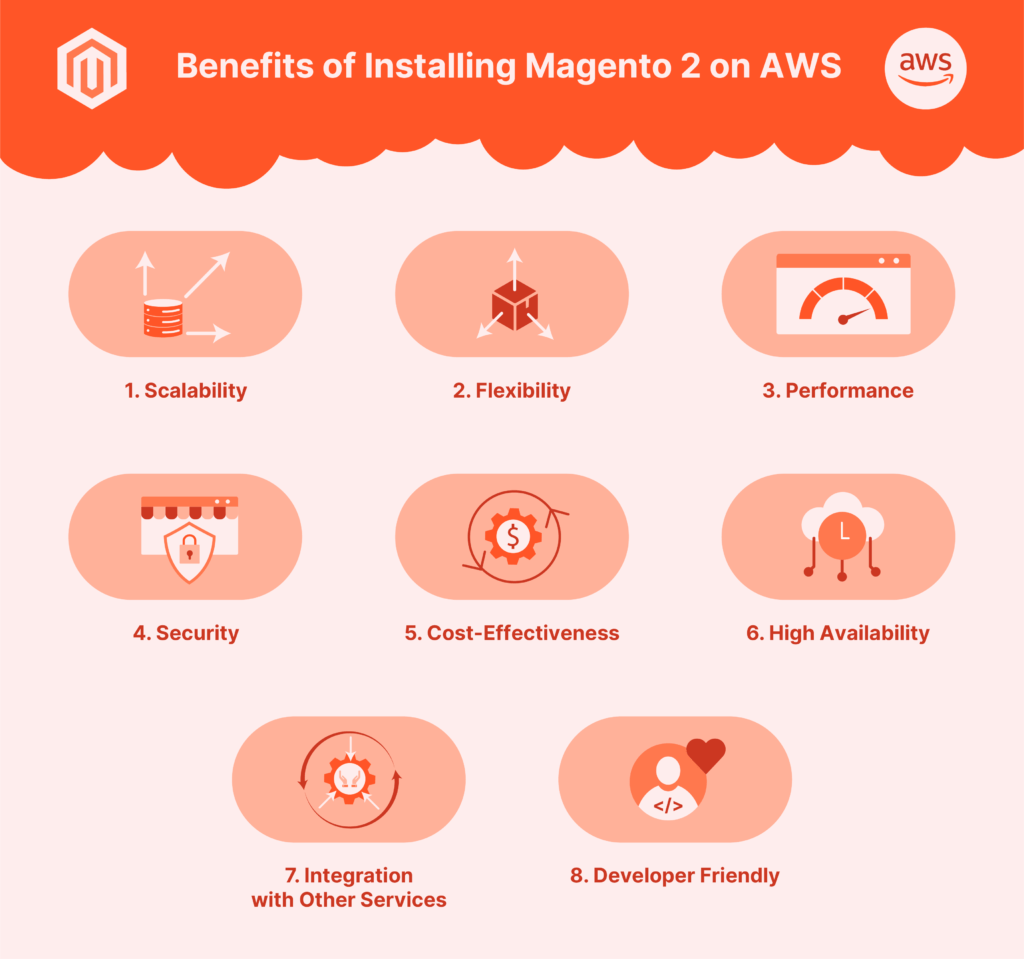
1. Scalability
AWS provides highly scalable cloud infrastructure. This means that as your ecommerce store grows, you can easily scale your resources up or down. It helps handle fluctuations in traffic and transactions without any downtime or performance loss.
2. Flexibility
AWS provides the flexibility to choose specific services and configurations. It helps you choose the one that matches your Magento store’s requirements. You can select from a variety of:
- Database solutions
- Compute resources
- Storage options.
These help tailor your environment to your needs.
3. Performance
AWS’s global network of data centers ensures that your Magento store can load quickly for customers worldwide. It reduces latency and improves user experience. Enhanced performance can be further achieved through AWS services like Amazon CloudFront.
Amazon CloudFront is a content delivery network. It caches copies of your store’s data at edge locations worldwide.
4. Security
AWS offers powerful security features. It helps protect your Magento store from threats. These include:
- Data encryption
- Network firewalls
- Identity access management.
AWS also complies with many compliance certifications. These ensure that you can meet regulatory requirements easily.
5. Cost-Effectiveness
AWS lets you pay only for the resources you use. It leads to cost savings compared to hosting on-premises. AWS’s pricing model allows for better cost management with options like:
- Reserved instances
- Spot pricing.
6. High Availability
AWS’s architecture supports high availability and disaster recovery. AWS automatically redistributes and balances the server load. It means that your Magento store can operate without significant disruptions in the event of a hardware failure.
7. Integration with Other Services
AWS offers a range of additional services that integrate well with Magento, such as:
- Amazon RDS for managed database services
- Amazon S3 for scalable storage
- AWS Lambda for running serverless applications.
The ecosystem allows for powerful extensions and enhancements to your e-commerce capabilities.
8. Developer Friendly
AWS provides extensive tools and SDKs for developers. These are integrated well with Magento, making it easier to deploy, manage, and innovate. The AWS Marketplace also features a variety of ready-to-deploy Magento configurations that can simplify the setup process.
Prerequisites of Installing Magento 2 on AWS
1. AWS Account
Set up an AWS account. The account will provide you access to all AWS services, including EC2, RDS, and S3. These are all you might need for your Magento installation.
2. Domain Name
Have a registered domain name that you can use for your Magento store. You will also need to manage DNS settings. It can be handled through Amazon Route 53 or another DNS provider.
3. SSL Certificate
SSL is required for secure data transmission and SEO benefits. It enables HTTPS on your site; this is especially essential for payment and user data. AWS Certificate Manager can provide and manage SSL certificates at no additional cost.
4. SSH Key Pair
Generate an SSH key pair for secure access to your AWS instance. AWS provides a straightforward way to create this during the instance setup.
5. Elastic IP
While not mandatory, you should assign an Elastic IP to your instance. It ensures that the IP address remains the same even if you stop and restart your instance.
6. Backup and Recovery Strategy
Plan how you will back up your Magento files and database. AWS offers several options for backup and disaster recovery, including:
- Amazon S3 for storing backups
- Amazon RDS for automated database snapshots.
7. Email Service
Magento requires an email-sending service for transactional emails. AWS SES (Simple Email Service) is an integrated way to send emails. You can also configure other SMTP providers.
8. Security Measures
Plan for security measures such as:
- Configuring firewalls and security groups in AWS to control access to your instances.
- Regular updates and patches for Magento and its components.
- Implementing network and application-level firewalls, such as AWS WAF.
9. Performance Monitoring Tools
Consider tools for monitoring your server and Magento application performance. AWS CloudWatch provides insights into:
- Resource utilization
- Application performance
- Operational health.
Technical Requirements of Installing Magento 2 on AWS
1. Operating System
Linux distributions such as CentOS, Ubuntu, or Debian are recommended. Magento 2 does not support Windows hosting.
2. Web Server
Apache 2.4 or higher with mod_rewrite enabled for SEO-friendly URLs. Nginx 1.x is also supported and is often preferred for performance reasons.
3. Database
MySQL 5.7 or higher. Magento 2 also supports MariaDB and other MySQL-compatible databases like Percona. These should be in specific versions, including:
- MariaDB 10.2 or higher
- Percona 5.7 or higher.
4. PHP
PHP 7.3.x or higher, with the following extensions installed:
- bcmath
- ctype
- curl
- dom
- gd
- hash
- iconv
- intl
- mbstring
- openssl
- pdo_mysql
- simplexml
- soap
- xsl
- zip
- json
- fileinfo.
It is also important to adjust PHP settings according to Magento’s requirements. These include memory_limit (at least 2GB recommended).
5. Memory Requirement
A minimum of 2 GB of RAM is required for Magento 2. 4 GB or more is recommended for better performance, especially in a production environment.
6. Required PHP Libraries
Composer is required for dependency management in Magento. PHPUnit (as a part of development tools) is essential for running tests.
7. Networking
Set up proper security groups and network ACLs to control traffic to and from your instances. Consider using Amazon Route 53 for DNS management. It integrates well with other Amazon web services.
8. Additional Tools and Services
a. Elasticsearch: Required by Magento 2.4 and later for catalog search capabilities.
b. Cron: Sets up the scheduling tasks required by Magento.
c. Mail Server: AWS SES (Simple Email Service) can be used to handle outbound emails.
d. Backup Solutions: Consider using AWS services like Amazon S3 for backup storage and AWS RDS features for database snapshots.
9. Storage
Use EBS (Elastic Block Store) volumes to store the Magento file system and media files. Ensure you choose the right type and size based on your performance and budget needs.
Steps to Install Magento 2 on AWS
1. Setup a Server on Amazon EC2
a. Log in to AWS Management Console and navigate to the EC2 Dashboard.
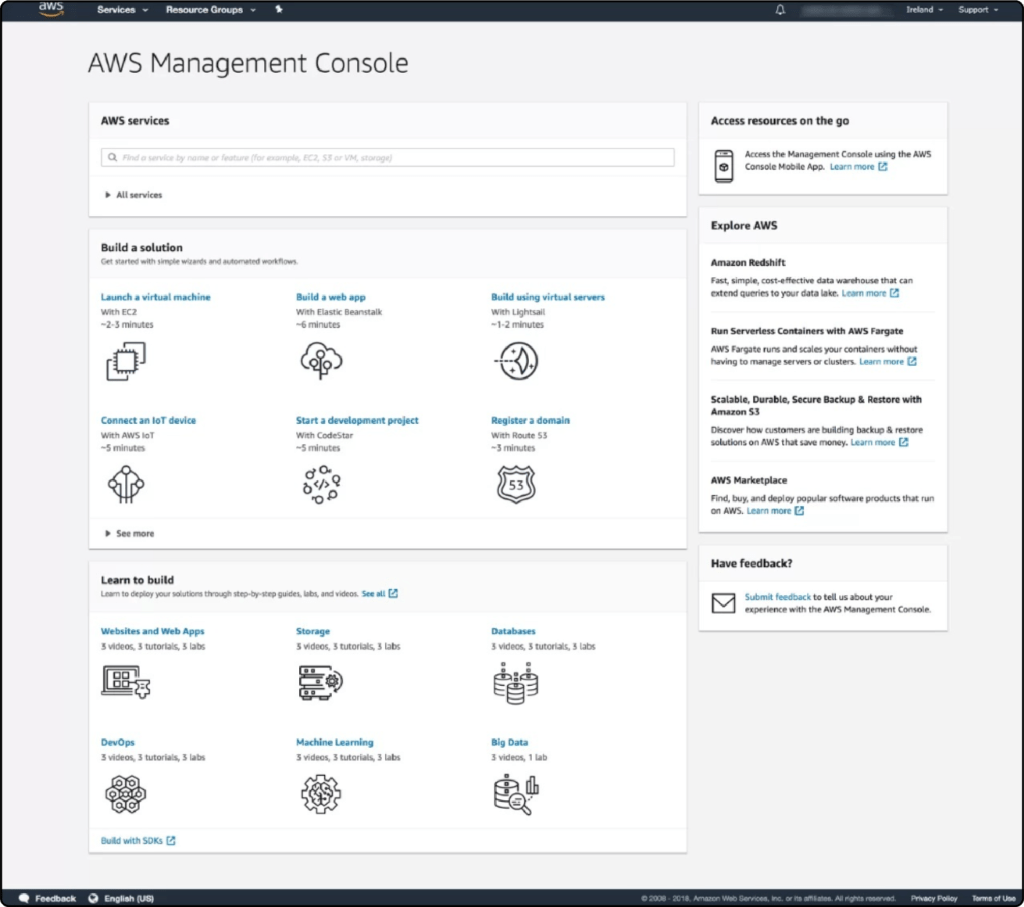
b. Launch a new instance:
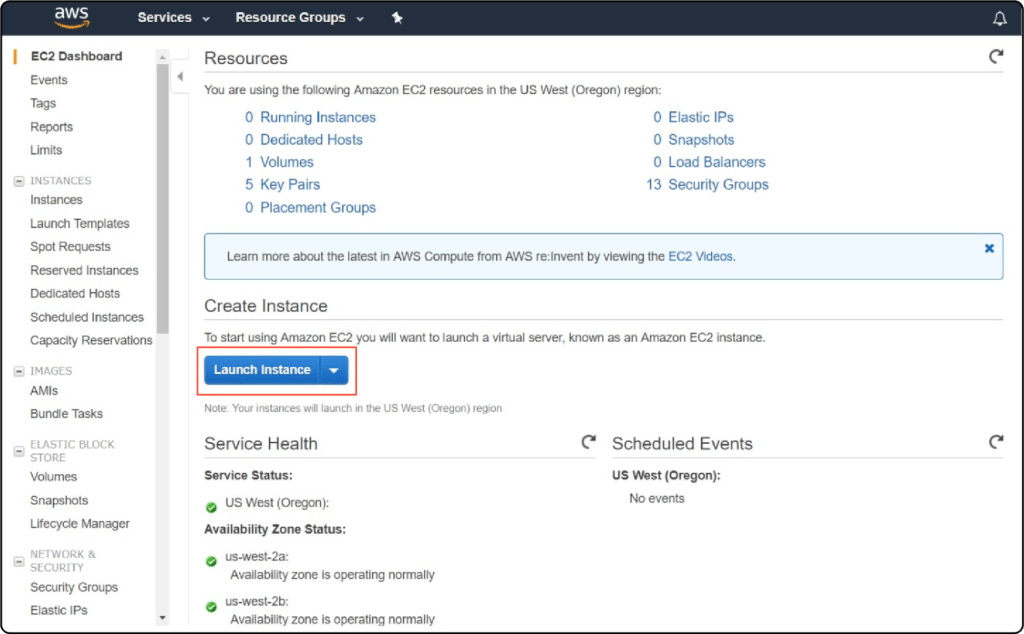
- Choose an appropriate AMI (Amazon Machine Image). These include Ubuntu, CentOS, or any other Linux distribution that supports Magento.
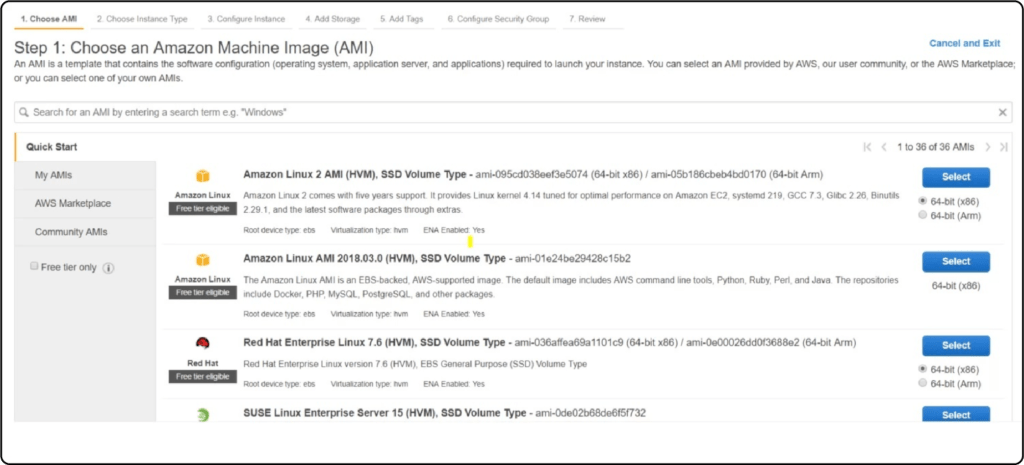
- Select an instance type (e.g., t2.medium or t2.large, depending on your expected traffic and performance requirements).
- Configure instance details like network and subnet. Assign a public IP if needed.
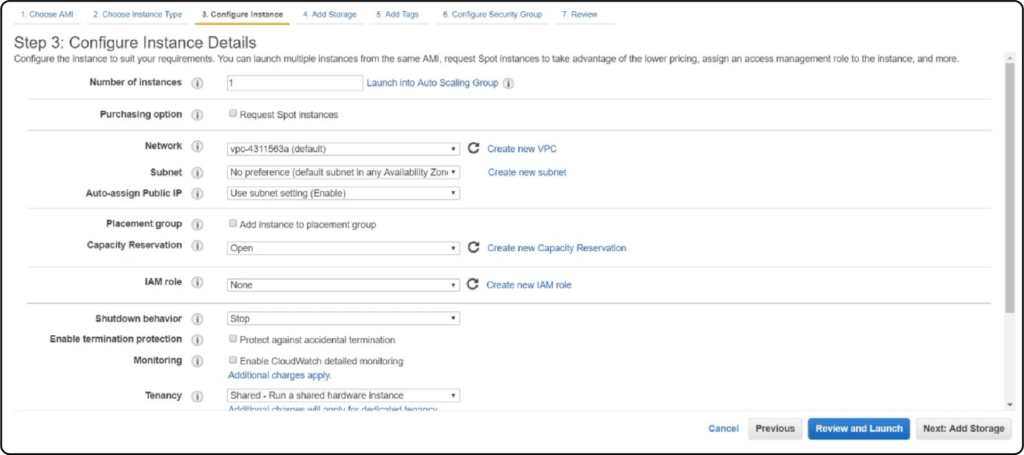
- Add storage according to your needs (SSD storage is recommended for better performance).
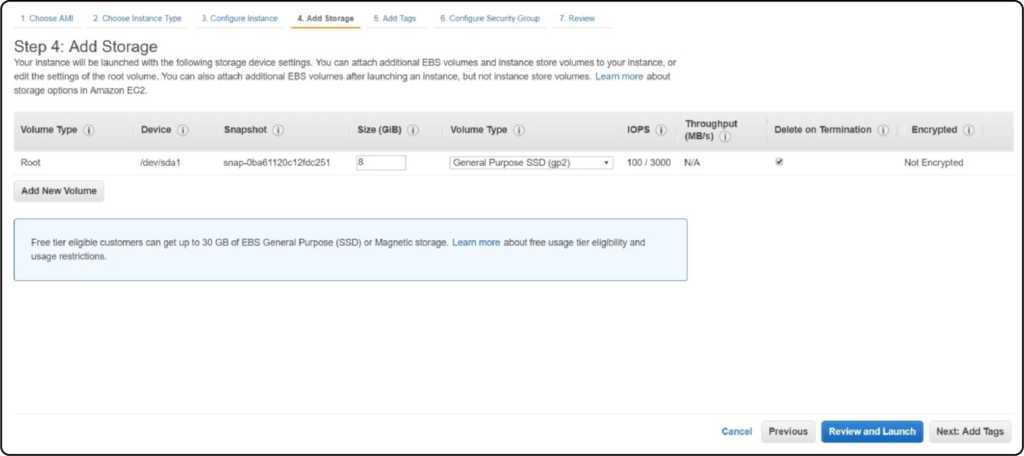
- Configure security groups to allow traffic on ports 80 (HTTP), 443 (HTTPS), and 22 (SSH).
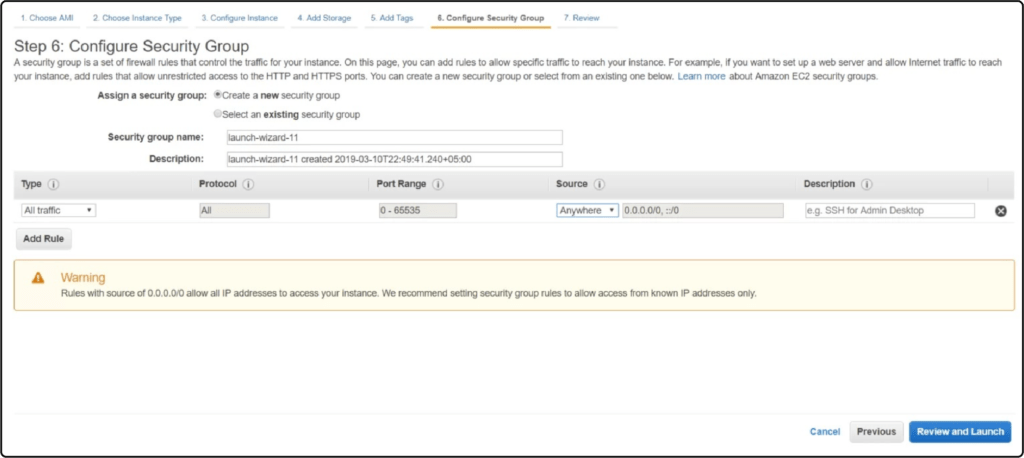
- Review and launch the instance, selecting a key pair for SSH access.
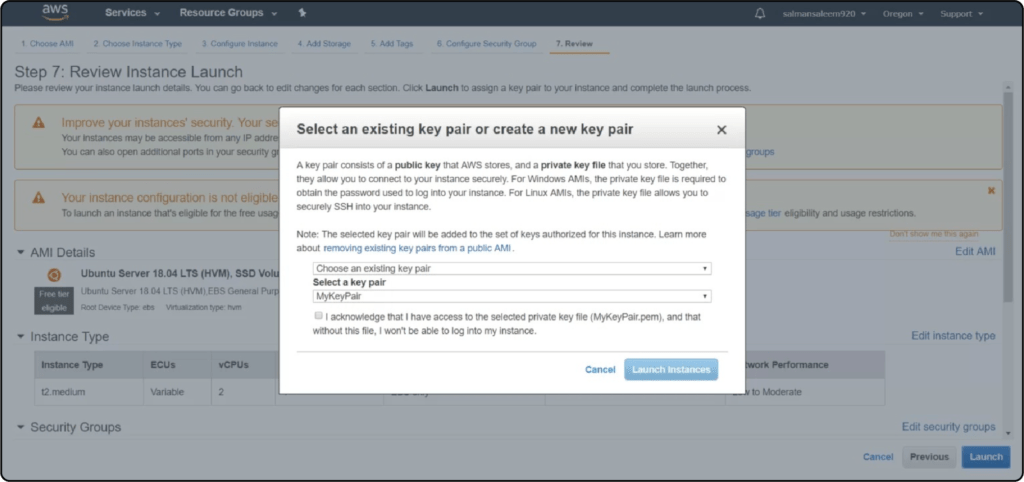
2. Install Prerequisite Tools on the Server
a. Connect to your instance via SSH using the key pair you selected during the setup.
b. Update your system packages by running the following code:
sudo apt-get update && sudo apt-get upgrade -y
c. Install Apache/Nginx:
sudo apt-get install apache2 or sudo apt-get install nginx
d. Install PHP and required extensions:
sudo apt-get install php7.4 php7.4-cli php7.4-common php7.4-mbstring php7.4-gd php7.4-intl php7.4-xml php7.4-mysql php7.4-zip php7.4-curl php7.4-soap php7.4-bcmath
e. Install Composer:
curl -sS https://getcomposer.org/installer | php sudo mv composer.phar /usr/local/bin/composer
3. Setup Database
a. Install MySQL:
sudo apt-get install mysql-server
b. Secure MySQL installation:
sudo mysql_secure_installation
c. Create a database for Magento:
mysql -u root -p CREATE DATABASE magento; GRANT ALL PRIVILEGES ON magento.* TO 'magento_user'@'localhost' IDENTIFIED BY 'password'; FLUSH PRIVILEGES; EXIT;
4. Install and Configure Magento on AWS Cloud
a. Download Magento:
composer create-project --repository-url=https://repo.magento.com/ magento/project-community-edition /var/www/html/magento
b. Permissions:
Set the appropriate permissions on the Magento directories:
sudo chown -R www-data:www-data /var/www/html/magento sudo find /var/www/html/magento -type f -exec chmod 644 {} \; sudo find /var/www/html/magento -type d -exec chmod 755 {} \;
c. Setup Magento:
Navigate to your Magento directory and run the setup script:
cd /var/www/html/magento sudo bin/magento setup:install --base-url=http://your_domain_or_IP/ \ --db-host=localhost --db-name=magento --db-user=magento_user --db-password=password \ --admin-firstname=admin --admin-lastname=admin --admin-email=admin@example.com \ --admin-user=admin --admin-password=admin123 --language=en_US \ --currency=USD --timezone=America/Chicago --use-rewrites=1
d. Configure Apache/Nginx:
Configure your web server to point to your Magento installation and enable URL rewrites to make URLs SEO-friendly.
5. Final Steps
a. Enable Magento cron jobs.
b. Disable default Magento mode and enable production mode for better performance:
sudo bin/magento deploy:mode:set production
Integration of oDesk Software Commerce with AWS
1. Streamlined Operations
oDesk Software Commerce is integrated with AWS. It helps eliminate the need for additional setup and configuration. It saves valuable time and resources.
2. Scalability
AWS provides unparalleled scalability. It allows oDesk Software Commerce to effortlessly handle fluctuations in traffic and demand without compromising performance.
3. Cost Efficiency
With AWS, oDesk Software Commerce benefits from a pay-as-you-go model. It ensures cost efficiency by only paying for the resources utilized. It reduces unnecessary expenses.
4. Security
AWS offers industry-leading security features. It ensures that oDesk Software Commerce hosting remains protected against potential threats. It gives peace of mind to both businesses and customers.
5. Enhanced Performance
The integration of oDesk Software Commerce with AWS results in improved speed and reliability. It helps provide a seamless shopping experience for customers and maximize sales potential.
Summary
Install Magento 2 on AWS to enhance the shopping experience through improved scalability and developer support. The tutorial also outlines:
- Key benefits of using AWS include scalable infrastructure, flexibility, improved performance, and powerful security.
- Prerequisites for installing Magento 2 on AWS include setting up an AWS account and obtaining an SSL certificate.
- Technical requirements include using a Linux-based operating system, Apache 2.4 or Nginx 1.x web servers, and MySQL 5.7.
- Installation steps start with setting up an Amazon EC2 server and installing prerequisite tools like Apache or Nginx and PHP.
Want to enhance your customer’s Magento e-commerce experience with hassle-free managed Magento hosting? Choose oDesk Software Commerce for the benefits of both Magento and AWS without the technical complexities.







